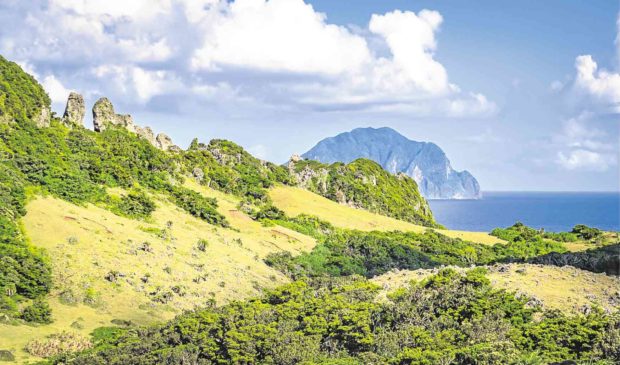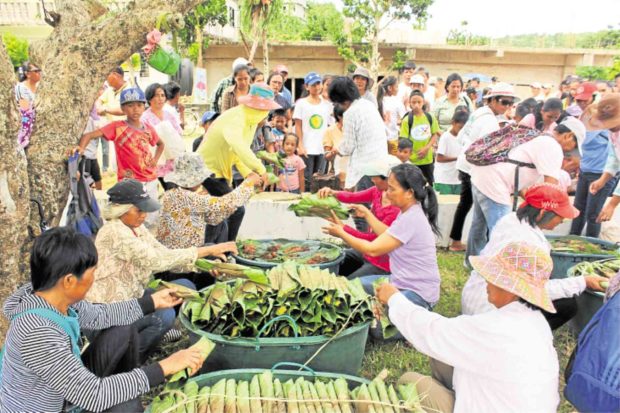Escape to quaint Itbayat

The Rappang Cliffs and stone formation have been popular trekking destinations for guests and local residents on this island in Batanes. —KURT IBAÑEZ
If paradise means clean air, no traffic and a quaint peaceful drug-free community, then that’s the description for Itbayat, the northernmost island town in Batanes province.
There are no beaches to speak of — just sheer limestone rock cliffs all around the island, rising 30 to more than 100 meters from the sea surface.
Itbayat, one of the world’s largest upturned coralline islands, is the domain of the Ivatan-Itbayat people as recognized by their certificate of ancestral domain title.
Trekking in an environment unspoiled by vehicle fumes, natural sea and landscapes with unusual rock formations, and the honest, gentle and cordial people are the main lures of the town.
No banks, hotels, market
No banks or market, just family home stores that offer food, snacks, bottled water and household needs. No hotels, too; only homestay or lodging houses, a nice getaway for a sabbatical to finish writing or reading a book.
Until 2013, tourists have had no public transport to avail of — just small Elf trucks that take them to places of interest, such as the view deck on Mount Caroboban and the Torongan Cave, where the first wave of Austronesians landed some 4,000 years ago in their migration toward the Pacific islands from Formosa.
These days, there are tricycles for hire — more like motorbikes with modified sidecars — but still no public transport so the basic equipment are still two feet moving one after the other.
Getting there sounds rather easy: Take a plane from Tuguegarao City in Cagayan province or the Manila Domestic Airport, land at Basco town in Batanes, head for the port, and ride a “faluwa” (iconic boat of Batanes) for Itbayat.
Weather check
But that’s provided you booked a flight from March to June, maybe even up to August, when the weather is fine and the sea is calm.
Come at other times of the year and you just might learn the wisdom of television science guy “Kuya Kim” Atienza, whose catchphrase is: “Laging tandaan — na ang buhay ay weder-weder lang (Just remember — life is like the changing weather).”
A woman once traveled to Itbayat for the Yuletide right after Typhoon “Ferdie” (international name: Meranti) blew through the town in September 2016. She expected to leave a day after Christmas only to be stranded there.
On the fourth day, with her android earplugs on, she was observed singing “Big Girls Don’t Cry” at the side of the “municipio” (town hall).

Itbayat residents wrap rice and meals in breadfruit leaves for the community “vunung” (feast). —NATHAN ALCANTARA
Fortunately, the Armed Forces North Luzon Command sent its C-295 plane to relieve soldiers assigned to their littoral monitoring detachment on Rizal Day, Dec. 30, and all the stranded tourists and islanders were airlifted for free.
Town fiesta
On Oct. 7, Itbayat marked its fiesta with newly installed Bishop Danilo Ulep of the Prelature of Batanes.
Though there is no account establishing the town’s age, it could be 218 years if reckoned from 1799 when the people were gathered to be counted for a census report and given the directive by the Spanish colonial government to build a community, which became the township of Itbayat.
Another year to consider is 1855, when the then parish priest was said to have founded “civilly and canonically the present town of Itbayat and called it Sta. Maria de Mayan.”
Long before, however, Itbayat was already teeming with people in scattered communities who occasionally sailed the seas and traded with villagers from neighboring islands.
An article by Ivatan scholar, Dr. Florentino Hornedo, describing cliff dwellings as a protection from attacks from unfriendly villages, could very well describe precolonial Itbayat.
“Now one understands better why the missionaries called the process of conquest ‘pacification.’ The aboriginal villages, like all peoples the world over before the institution of modern civil communities, were in a constant ‘state of war’ with each other,” Hornedo wrote.
When the missionaries came, some residents fled, afraid of the Spaniards and their tough brand of catechism. But other preachers persisted and came up with less harsh and better ways of spreading the gospel. Eventually, Catholicism took root and spread wide.
“Because of the efforts of early missionaries, we are now enjoying the fruit of their labors—peace, harmony and a supportive community with almost zero crime. —CONTRIBUTED














